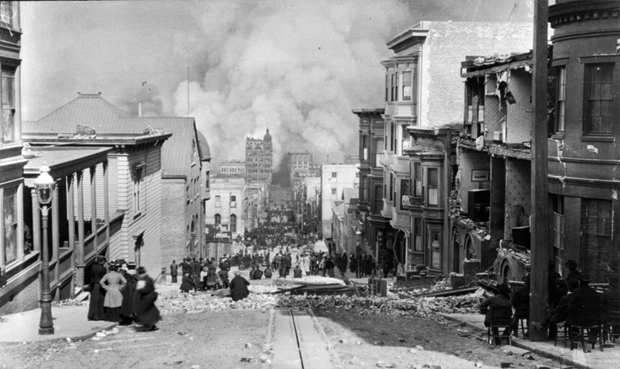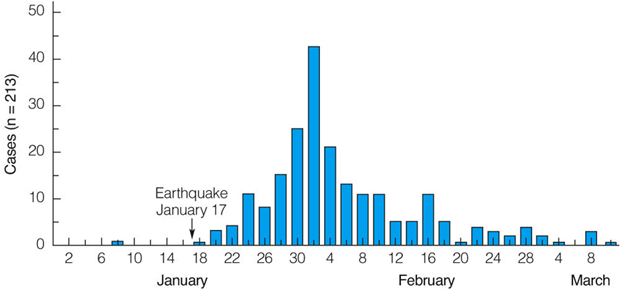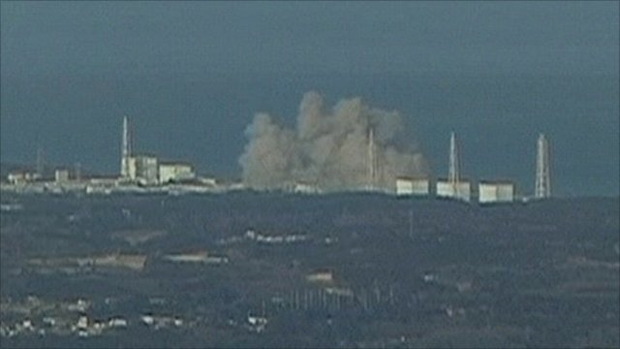12 March 2011
Secondary effects
Posted by Callan Bentley
Earthquakes themselves are rarely directly responsible for deaths… If you’re out in a field, or a park, it’s a disorienting experience, and you may see some weird stuff, but you’re not likely to be killed via whiplash. Usually, casualties are induced due to the collapse of buildings, or roads, bridges, tunnels, or other infrastructure failing due to being shaken by the seismic waves. Someone paraphrased the NRA yesterday with the quip that “earthquakes don’t kill people, buildings kill people.”
And then there are the “secondary effects,” a misleading name, given that they are frequently the primary cause of death and destruction. Yesterday’s tsunami is an example of a secondary effect, and a tremendously deadly one. Here are a few others.
After the “great” San Francisco earthquake of 1906, German photographer Arnold Genthe borrowed a camera and went out onto Sacramento Street and looked downhill. (Simon Winchester tells this story well in A Crack in the Edge of the World.) Genthe then took this iconic image:
 (source: Wikipedia)
(source: Wikipedia)
You can see that there are a bunch of well dressed San Franciscans there, amid a bunch of rubble, but not amid a wasteland of destruction. Their gaze, however, is the same as Genthe’s — looking east at billowing plumes of smoke down in the Marina district. The earthquake is over, but the city is not yet destroyed. The destroyer however, is on its way: fire. The earthquake broke some gas lines, which ignited, and set the nearby buildings (of redwood construction) afire, and then that was the tinder that set the rest of the city ablaze. The fires lasted three days. 700 people died, and in excess of 250,000 were rendered homeless. Really, the event is best remembered as the Great San Francisco Earthquake and Fire, but that’s a rather long moniker.
Another problem with earthquakes is that they often trigger landslides. Those landslides raise up a lost of dust, and that dust can cause disease, for instance if it carries spores of fungus. One “textbook” example followed California’s Northridge earthquake in 1994: dust from landslides in the Santa Susana Mountains drifted over Simi Valley, California, and caused an outbreak of coccidioidomycosis, also known as “Valley fever”:
 (source: Pipkin, Trent, Hazlett, & Bierman, 2011)
(source: Pipkin, Trent, Hazlett, & Bierman, 2011)
Now, in Japan, we are looking at something which may or may not be the catastrophic meltdown of a reactor in a nuclear power plant. Evelyn Mervine of Georneys conducted an interview this morning with her father, a nuclear engineer, on the situation in Japan. There was a dramatic explosion there this morning, but engineers at the site report that the reactor itself is not in imminent danger of a full meltdown.
 (source: BBC)
(source: BBC)
At the moment, the news suggests that this reactor is going to be cooled down through a last-ditch effort to cool the reactor with seawater doped with boron. Hopefully that will work. If it does, we will all breathe sigh of relief. However, what about a situation where the meltdown is not stopped in time? Not necessarily today in Japan, but in some future earthquake at some other nuclear power plant. (San Onofre comes to mind…) Surely that would go down in the record books as one of the greatest environmental catastrophes in human history.
It would be the ultimate secondary effect.


 Callan Bentley is Associate Professor of Geology at Piedmont Virginia Community College in Charlottesville, Virginia. He is a Fellow of the Geological Society of America. For his work on this blog, the National Association of Geoscience Teachers recognized him with the James Shea Award. He has also won the Outstanding Faculty Award from the State Council on Higher Education in Virginia, and the Biggs Award for Excellence in Geoscience Teaching from the Geoscience Education Division of the Geological Society of America. In previous years, Callan served as a contributing editor at EARTH magazine, President of the Geological Society of Washington and President the Geo2YC division of NAGT.
Callan Bentley is Associate Professor of Geology at Piedmont Virginia Community College in Charlottesville, Virginia. He is a Fellow of the Geological Society of America. For his work on this blog, the National Association of Geoscience Teachers recognized him with the James Shea Award. He has also won the Outstanding Faculty Award from the State Council on Higher Education in Virginia, and the Biggs Award for Excellence in Geoscience Teaching from the Geoscience Education Division of the Geological Society of America. In previous years, Callan served as a contributing editor at EARTH magazine, President of the Geological Society of Washington and President the Geo2YC division of NAGT.
Those people in San Francisco were well dressed because they put on their most valuable portable possessions. Many people were wearing multiple layers, and you can bet that their pockets were stuffed with cash, jewelry, important papers and other valuables.
[…] Mountain Beltway […]